Qualitative Analysis Report: Bushfire Impact Using Open & Axial Coding
VerifiedAdded on 2023/06/18
|9
|2025
|174
Report
AI Summary
This report presents a qualitative analysis of the impact of bushfires, employing open and axial coding techniques to interpret interview data from affected individuals. The study explores themes such as preparedness, perceived risk, information sources, and community discussions related to bushfires. Through descriptive statistics derived from coded data, the research identifies key factors influencing people's experiences and responses to bushfire threats. The analysis reveals that prior experiences with fires significantly shape preparedness strategies, and that community discussions and access to reliable information play crucial roles in mitigating risk. The report concludes by emphasizing the importance of integrating theoretical knowledge with statistical tools for effective qualitative research, highlighting the value of understanding both the tangible and intangible impacts of bushfires on individuals and communities. Desklib provides access to this and many other solved assignments.
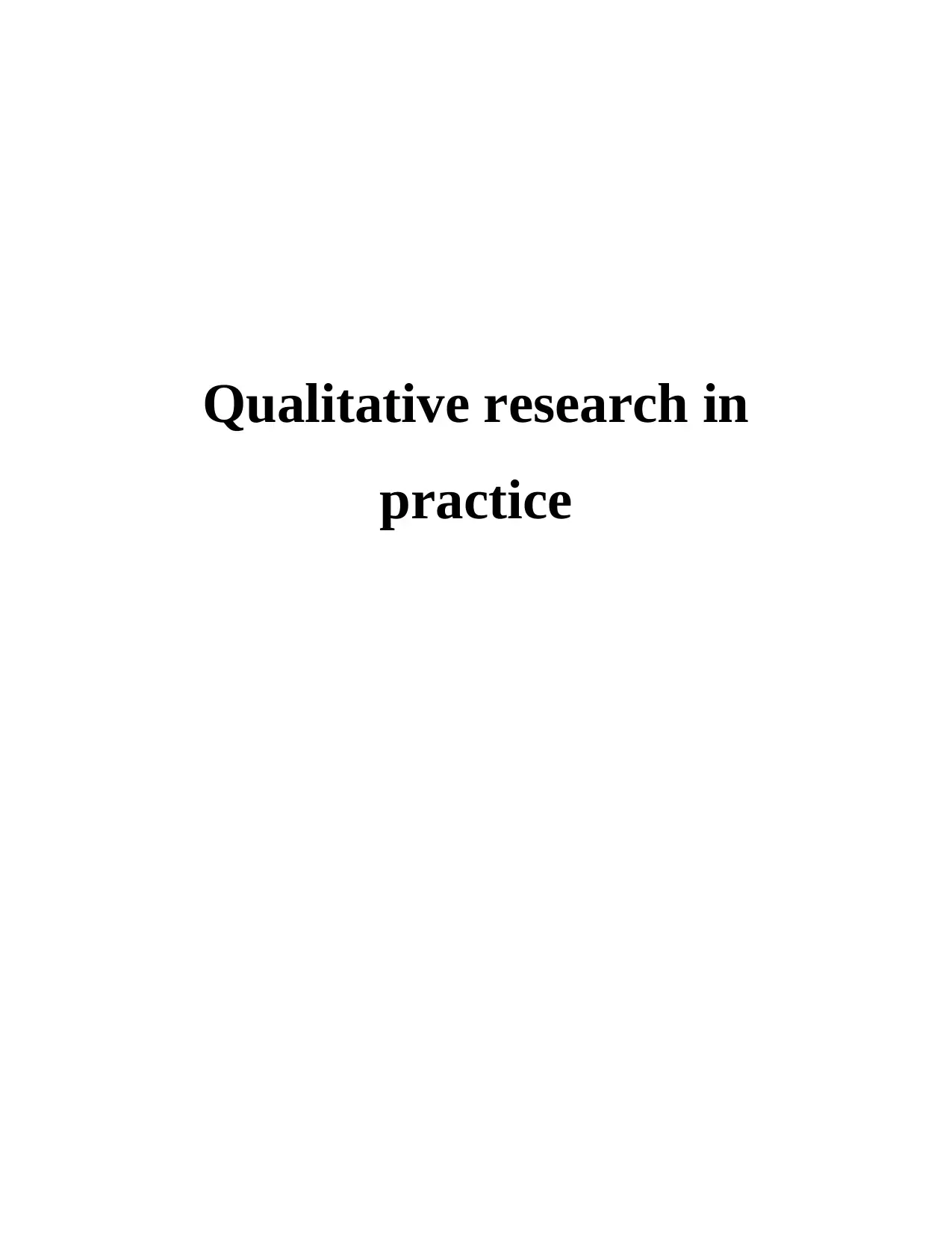
Qualitative research in
practice
practice
Paraphrase This Document
Need a fresh take? Get an instant paraphrase of this document with our AI Paraphraser
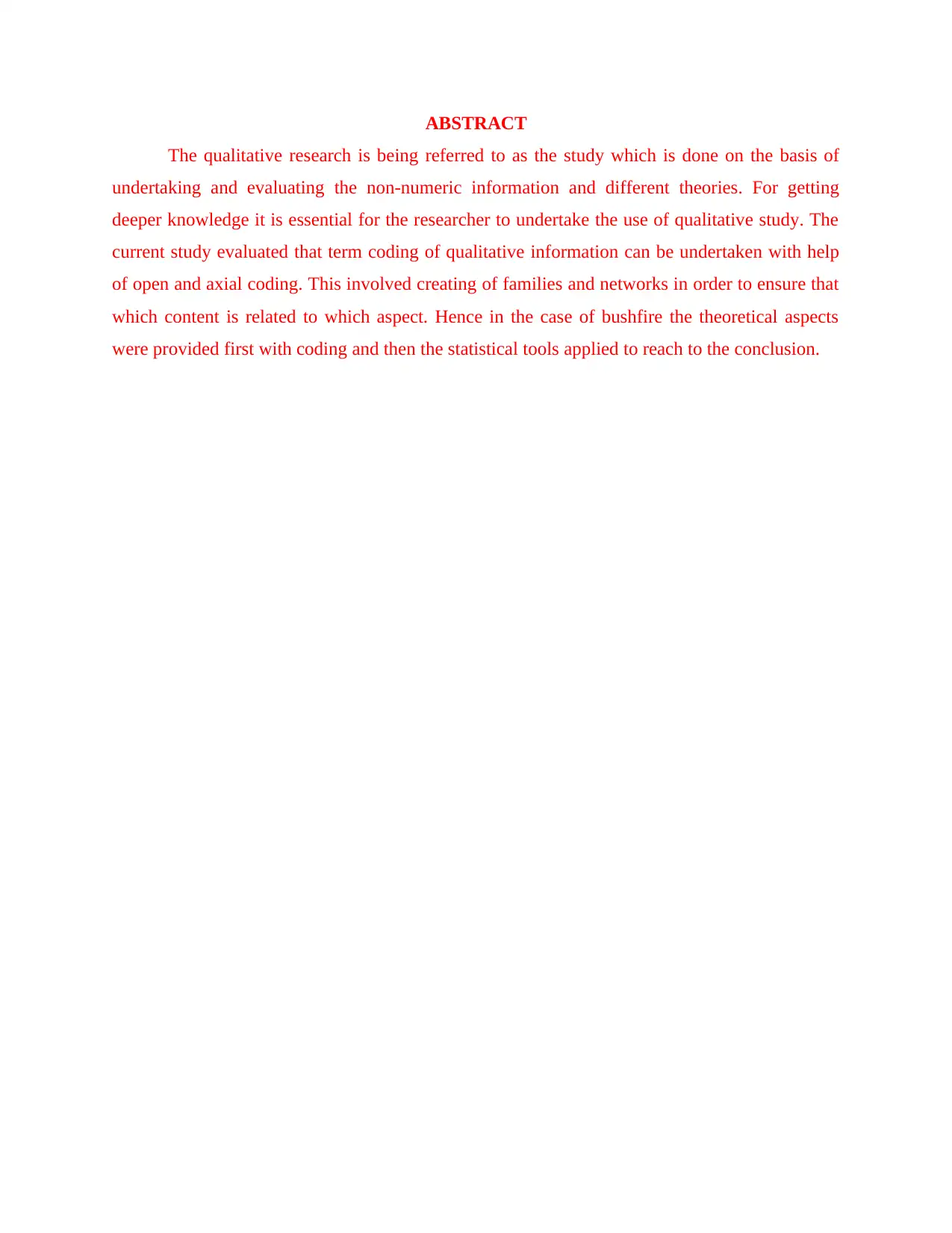
ABSTRACT
The qualitative research is being referred to as the study which is done on the basis of
undertaking and evaluating the non-numeric information and different theories. For getting
deeper knowledge it is essential for the researcher to undertake the use of qualitative study. The
current study evaluated that term coding of qualitative information can be undertaken with help
of open and axial coding. This involved creating of families and networks in order to ensure that
which content is related to which aspect. Hence in the case of bushfire the theoretical aspects
were provided first with coding and then the statistical tools applied to reach to the conclusion.
The qualitative research is being referred to as the study which is done on the basis of
undertaking and evaluating the non-numeric information and different theories. For getting
deeper knowledge it is essential for the researcher to undertake the use of qualitative study. The
current study evaluated that term coding of qualitative information can be undertaken with help
of open and axial coding. This involved creating of families and networks in order to ensure that
which content is related to which aspect. Hence in the case of bushfire the theoretical aspects
were provided first with coding and then the statistical tools applied to reach to the conclusion.
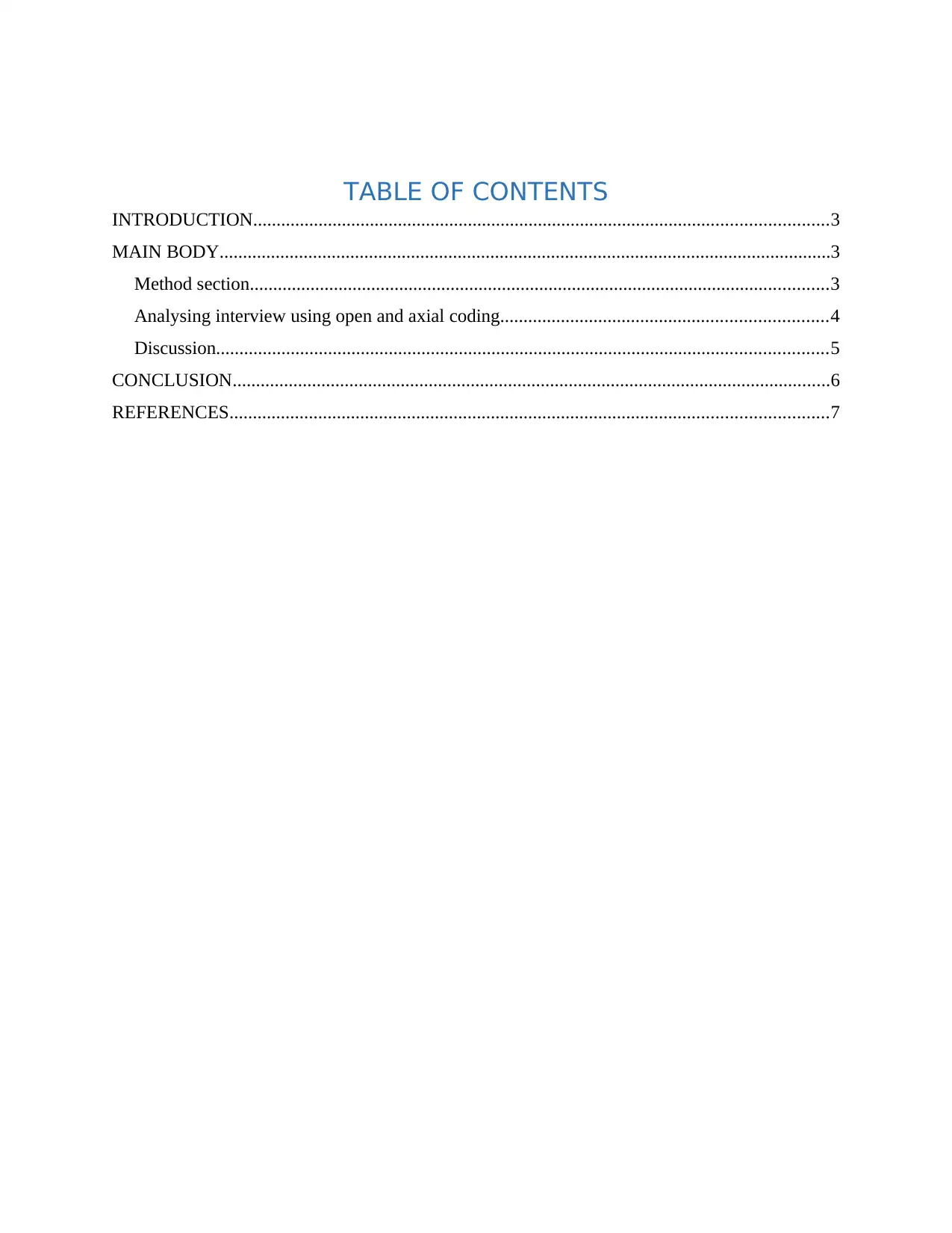
TABLE OF CONTENTS
INTRODUCTION...........................................................................................................................3
MAIN BODY...................................................................................................................................3
Method section............................................................................................................................3
Analysing interview using open and axial coding......................................................................4
Discussion...................................................................................................................................5
CONCLUSION................................................................................................................................6
REFERENCES................................................................................................................................7
INTRODUCTION...........................................................................................................................3
MAIN BODY...................................................................................................................................3
Method section............................................................................................................................3
Analysing interview using open and axial coding......................................................................4
Discussion...................................................................................................................................5
CONCLUSION................................................................................................................................6
REFERENCES................................................................................................................................7
⊘ This is a preview!⊘
Do you want full access?
Subscribe today to unlock all pages.

Trusted by 1+ million students worldwide
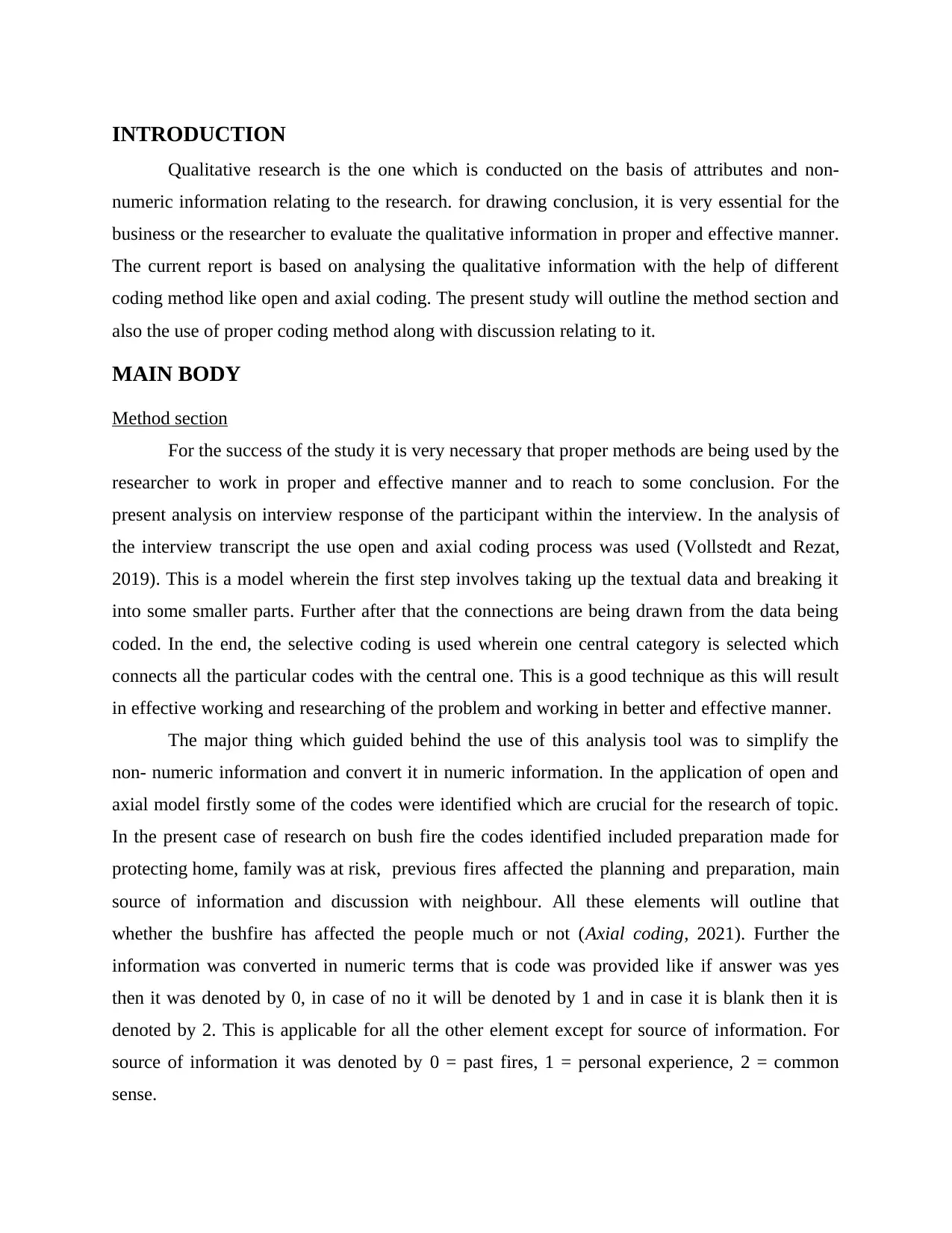
INTRODUCTION
Qualitative research is the one which is conducted on the basis of attributes and non-
numeric information relating to the research. for drawing conclusion, it is very essential for the
business or the researcher to evaluate the qualitative information in proper and effective manner.
The current report is based on analysing the qualitative information with the help of different
coding method like open and axial coding. The present study will outline the method section and
also the use of proper coding method along with discussion relating to it.
MAIN BODY
Method section
For the success of the study it is very necessary that proper methods are being used by the
researcher to work in proper and effective manner and to reach to some conclusion. For the
present analysis on interview response of the participant within the interview. In the analysis of
the interview transcript the use open and axial coding process was used (Vollstedt and Rezat,
2019). This is a model wherein the first step involves taking up the textual data and breaking it
into some smaller parts. Further after that the connections are being drawn from the data being
coded. In the end, the selective coding is used wherein one central category is selected which
connects all the particular codes with the central one. This is a good technique as this will result
in effective working and researching of the problem and working in better and effective manner.
The major thing which guided behind the use of this analysis tool was to simplify the
non- numeric information and convert it in numeric information. In the application of open and
axial model firstly some of the codes were identified which are crucial for the research of topic.
In the present case of research on bush fire the codes identified included preparation made for
protecting home, family was at risk, previous fires affected the planning and preparation, main
source of information and discussion with neighbour. All these elements will outline that
whether the bushfire has affected the people much or not (Axial coding, 2021). Further the
information was converted in numeric terms that is code was provided like if answer was yes
then it was denoted by 0, in case of no it will be denoted by 1 and in case it is blank then it is
denoted by 2. This is applicable for all the other element except for source of information. For
source of information it was denoted by 0 = past fires, 1 = personal experience, 2 = common
sense.
Qualitative research is the one which is conducted on the basis of attributes and non-
numeric information relating to the research. for drawing conclusion, it is very essential for the
business or the researcher to evaluate the qualitative information in proper and effective manner.
The current report is based on analysing the qualitative information with the help of different
coding method like open and axial coding. The present study will outline the method section and
also the use of proper coding method along with discussion relating to it.
MAIN BODY
Method section
For the success of the study it is very necessary that proper methods are being used by the
researcher to work in proper and effective manner and to reach to some conclusion. For the
present analysis on interview response of the participant within the interview. In the analysis of
the interview transcript the use open and axial coding process was used (Vollstedt and Rezat,
2019). This is a model wherein the first step involves taking up the textual data and breaking it
into some smaller parts. Further after that the connections are being drawn from the data being
coded. In the end, the selective coding is used wherein one central category is selected which
connects all the particular codes with the central one. This is a good technique as this will result
in effective working and researching of the problem and working in better and effective manner.
The major thing which guided behind the use of this analysis tool was to simplify the
non- numeric information and convert it in numeric information. In the application of open and
axial model firstly some of the codes were identified which are crucial for the research of topic.
In the present case of research on bush fire the codes identified included preparation made for
protecting home, family was at risk, previous fires affected the planning and preparation, main
source of information and discussion with neighbour. All these elements will outline that
whether the bushfire has affected the people much or not (Axial coding, 2021). Further the
information was converted in numeric terms that is code was provided like if answer was yes
then it was denoted by 0, in case of no it will be denoted by 1 and in case it is blank then it is
denoted by 2. This is applicable for all the other element except for source of information. For
source of information it was denoted by 0 = past fires, 1 = personal experience, 2 = common
sense.
Paraphrase This Document
Need a fresh take? Get an instant paraphrase of this document with our AI Paraphraser
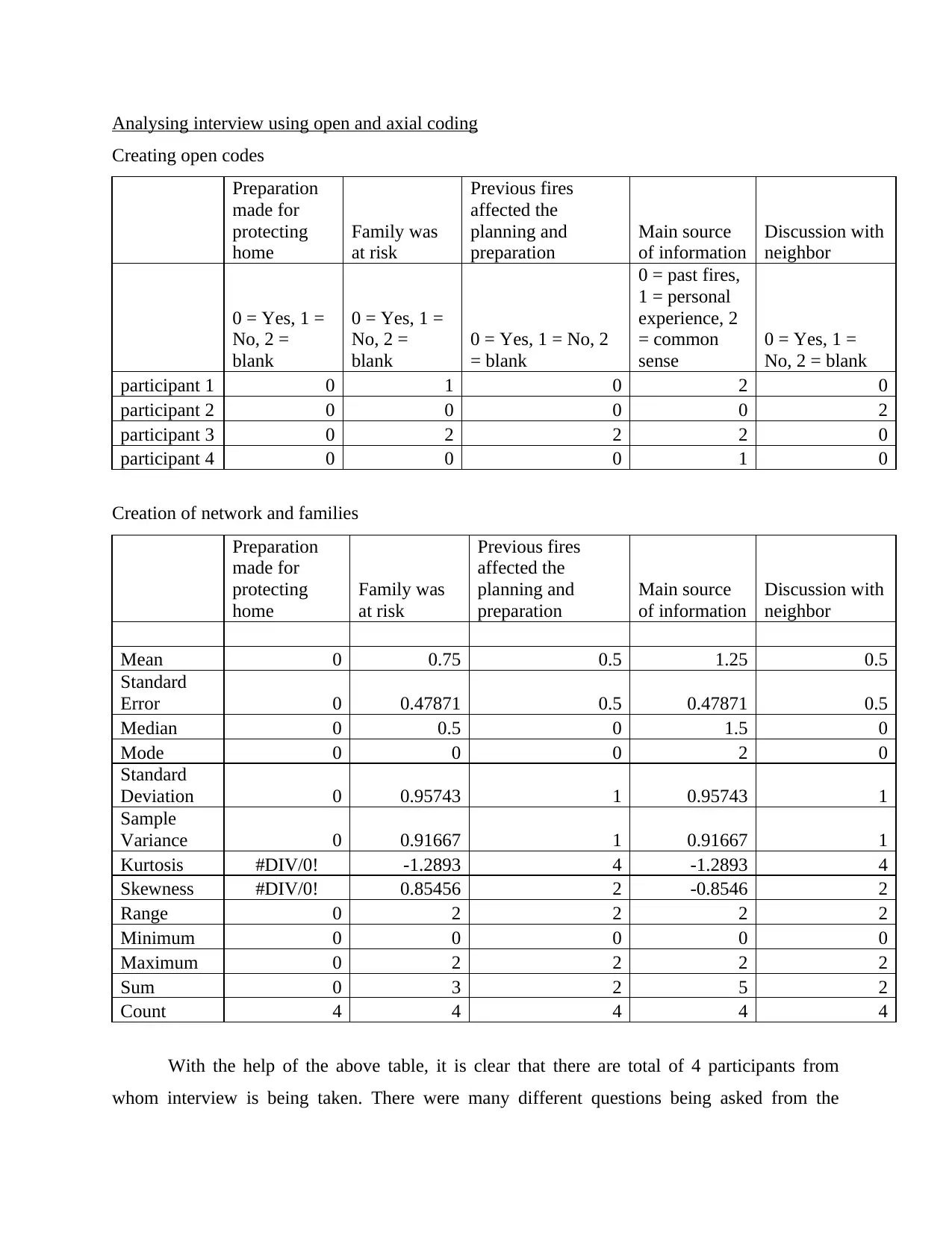
Analysing interview using open and axial coding
Creating open codes
Preparation
made for
protecting
home
Family was
at risk
Previous fires
affected the
planning and
preparation
Main source
of information
Discussion with
neighbor
0 = Yes, 1 =
No, 2 =
blank
0 = Yes, 1 =
No, 2 =
blank
0 = Yes, 1 = No, 2
= blank
0 = past fires,
1 = personal
experience, 2
= common
sense
0 = Yes, 1 =
No, 2 = blank
participant 1 0 1 0 2 0
participant 2 0 0 0 0 2
participant 3 0 2 2 2 0
participant 4 0 0 0 1 0
Creation of network and families
Preparation
made for
protecting
home
Family was
at risk
Previous fires
affected the
planning and
preparation
Main source
of information
Discussion with
neighbor
Mean 0 0.75 0.5 1.25 0.5
Standard
Error 0 0.47871 0.5 0.47871 0.5
Median 0 0.5 0 1.5 0
Mode 0 0 0 2 0
Standard
Deviation 0 0.95743 1 0.95743 1
Sample
Variance 0 0.91667 1 0.91667 1
Kurtosis #DIV/0! -1.2893 4 -1.2893 4
Skewness #DIV/0! 0.85456 2 -0.8546 2
Range 0 2 2 2 2
Minimum 0 0 0 0 0
Maximum 0 2 2 2 2
Sum 0 3 2 5 2
Count 4 4 4 4 4
With the help of the above table, it is clear that there are total of 4 participants from
whom interview is being taken. There were many different questions being asked from the
Creating open codes
Preparation
made for
protecting
home
Family was
at risk
Previous fires
affected the
planning and
preparation
Main source
of information
Discussion with
neighbor
0 = Yes, 1 =
No, 2 =
blank
0 = Yes, 1 =
No, 2 =
blank
0 = Yes, 1 = No, 2
= blank
0 = past fires,
1 = personal
experience, 2
= common
sense
0 = Yes, 1 =
No, 2 = blank
participant 1 0 1 0 2 0
participant 2 0 0 0 0 2
participant 3 0 2 2 2 0
participant 4 0 0 0 1 0
Creation of network and families
Preparation
made for
protecting
home
Family was
at risk
Previous fires
affected the
planning and
preparation
Main source
of information
Discussion with
neighbor
Mean 0 0.75 0.5 1.25 0.5
Standard
Error 0 0.47871 0.5 0.47871 0.5
Median 0 0.5 0 1.5 0
Mode 0 0 0 2 0
Standard
Deviation 0 0.95743 1 0.95743 1
Sample
Variance 0 0.91667 1 0.91667 1
Kurtosis #DIV/0! -1.2893 4 -1.2893 4
Skewness #DIV/0! 0.85456 2 -0.8546 2
Range 0 2 2 2 2
Minimum 0 0 0 0 0
Maximum 0 2 2 2 2
Sum 0 3 2 5 2
Count 4 4 4 4 4
With the help of the above table, it is clear that there are total of 4 participants from
whom interview is being taken. There were many different questions being asked from the
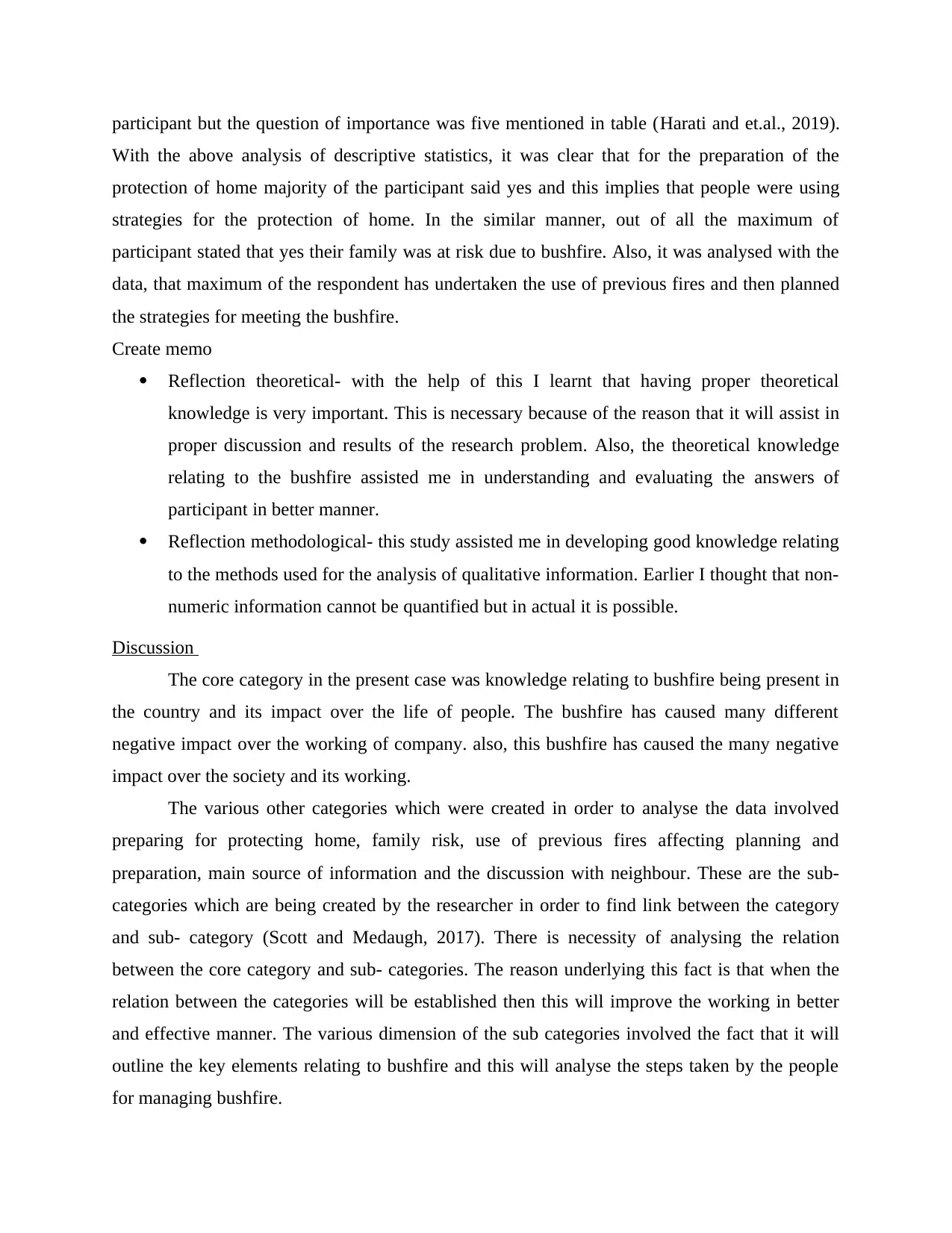
participant but the question of importance was five mentioned in table (Harati and et.al., 2019).
With the above analysis of descriptive statistics, it was clear that for the preparation of the
protection of home majority of the participant said yes and this implies that people were using
strategies for the protection of home. In the similar manner, out of all the maximum of
participant stated that yes their family was at risk due to bushfire. Also, it was analysed with the
data, that maximum of the respondent has undertaken the use of previous fires and then planned
the strategies for meeting the bushfire.
Create memo
Reflection theoretical- with the help of this I learnt that having proper theoretical
knowledge is very important. This is necessary because of the reason that it will assist in
proper discussion and results of the research problem. Also, the theoretical knowledge
relating to the bushfire assisted me in understanding and evaluating the answers of
participant in better manner.
Reflection methodological- this study assisted me in developing good knowledge relating
to the methods used for the analysis of qualitative information. Earlier I thought that non-
numeric information cannot be quantified but in actual it is possible.
Discussion
The core category in the present case was knowledge relating to bushfire being present in
the country and its impact over the life of people. The bushfire has caused many different
negative impact over the working of company. also, this bushfire has caused the many negative
impact over the society and its working.
The various other categories which were created in order to analyse the data involved
preparing for protecting home, family risk, use of previous fires affecting planning and
preparation, main source of information and the discussion with neighbour. These are the sub-
categories which are being created by the researcher in order to find link between the category
and sub- category (Scott and Medaugh, 2017). There is necessity of analysing the relation
between the core category and sub- categories. The reason underlying this fact is that when the
relation between the categories will be established then this will improve the working in better
and effective manner. The various dimension of the sub categories involved the fact that it will
outline the key elements relating to bushfire and this will analyse the steps taken by the people
for managing bushfire.
With the above analysis of descriptive statistics, it was clear that for the preparation of the
protection of home majority of the participant said yes and this implies that people were using
strategies for the protection of home. In the similar manner, out of all the maximum of
participant stated that yes their family was at risk due to bushfire. Also, it was analysed with the
data, that maximum of the respondent has undertaken the use of previous fires and then planned
the strategies for meeting the bushfire.
Create memo
Reflection theoretical- with the help of this I learnt that having proper theoretical
knowledge is very important. This is necessary because of the reason that it will assist in
proper discussion and results of the research problem. Also, the theoretical knowledge
relating to the bushfire assisted me in understanding and evaluating the answers of
participant in better manner.
Reflection methodological- this study assisted me in developing good knowledge relating
to the methods used for the analysis of qualitative information. Earlier I thought that non-
numeric information cannot be quantified but in actual it is possible.
Discussion
The core category in the present case was knowledge relating to bushfire being present in
the country and its impact over the life of people. The bushfire has caused many different
negative impact over the working of company. also, this bushfire has caused the many negative
impact over the society and its working.
The various other categories which were created in order to analyse the data involved
preparing for protecting home, family risk, use of previous fires affecting planning and
preparation, main source of information and the discussion with neighbour. These are the sub-
categories which are being created by the researcher in order to find link between the category
and sub- category (Scott and Medaugh, 2017). There is necessity of analysing the relation
between the core category and sub- categories. The reason underlying this fact is that when the
relation between the categories will be established then this will improve the working in better
and effective manner. The various dimension of the sub categories involved the fact that it will
outline the key elements relating to bushfire and this will analyse the steps taken by the people
for managing bushfire.
⊘ This is a preview!⊘
Do you want full access?
Subscribe today to unlock all pages.

Trusted by 1+ million students worldwide
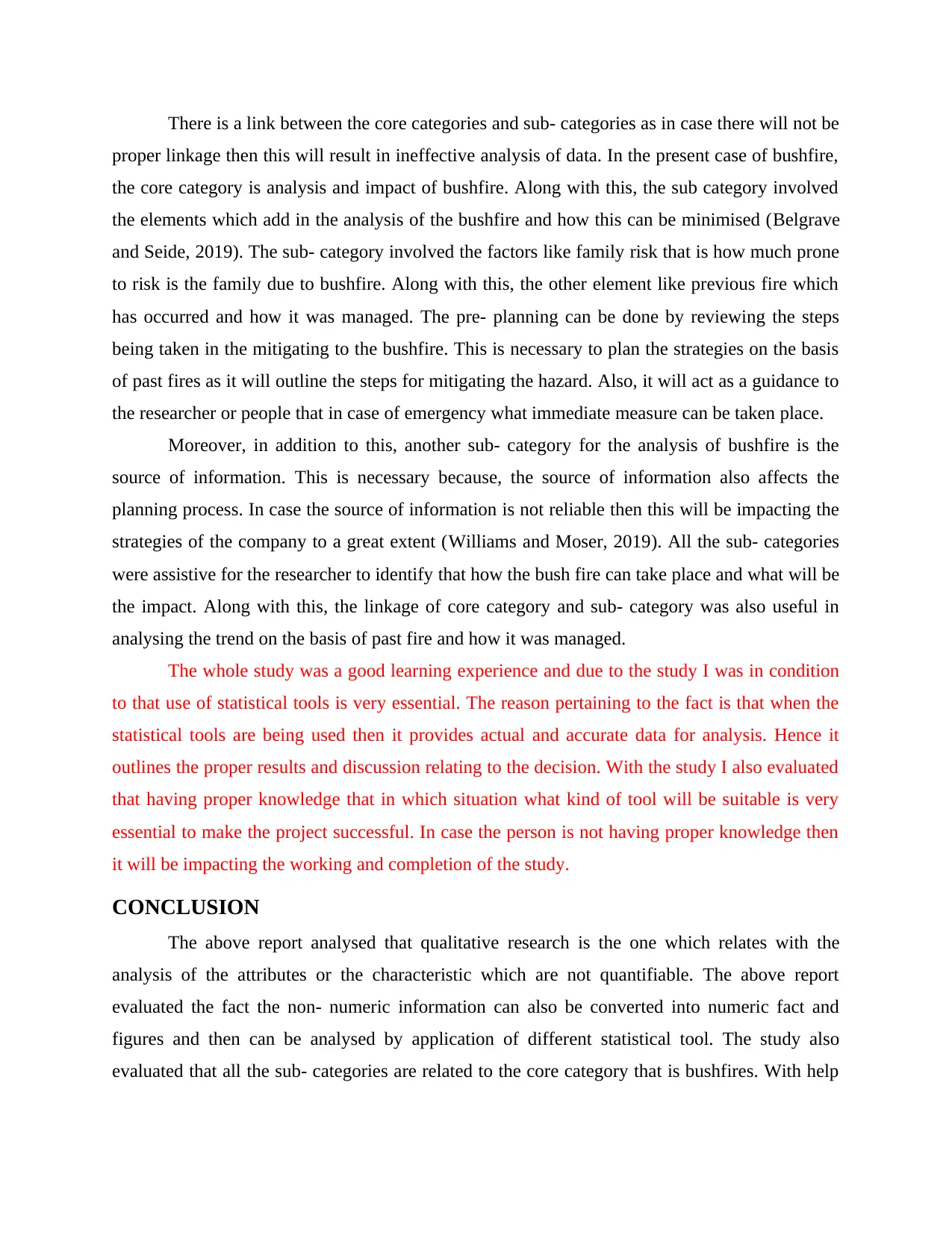
There is a link between the core categories and sub- categories as in case there will not be
proper linkage then this will result in ineffective analysis of data. In the present case of bushfire,
the core category is analysis and impact of bushfire. Along with this, the sub category involved
the elements which add in the analysis of the bushfire and how this can be minimised (Belgrave
and Seide, 2019). The sub- category involved the factors like family risk that is how much prone
to risk is the family due to bushfire. Along with this, the other element like previous fire which
has occurred and how it was managed. The pre- planning can be done by reviewing the steps
being taken in the mitigating to the bushfire. This is necessary to plan the strategies on the basis
of past fires as it will outline the steps for mitigating the hazard. Also, it will act as a guidance to
the researcher or people that in case of emergency what immediate measure can be taken place.
Moreover, in addition to this, another sub- category for the analysis of bushfire is the
source of information. This is necessary because, the source of information also affects the
planning process. In case the source of information is not reliable then this will be impacting the
strategies of the company to a great extent (Williams and Moser, 2019). All the sub- categories
were assistive for the researcher to identify that how the bush fire can take place and what will be
the impact. Along with this, the linkage of core category and sub- category was also useful in
analysing the trend on the basis of past fire and how it was managed.
The whole study was a good learning experience and due to the study I was in condition
to that use of statistical tools is very essential. The reason pertaining to the fact is that when the
statistical tools are being used then it provides actual and accurate data for analysis. Hence it
outlines the proper results and discussion relating to the decision. With the study I also evaluated
that having proper knowledge that in which situation what kind of tool will be suitable is very
essential to make the project successful. In case the person is not having proper knowledge then
it will be impacting the working and completion of the study.
CONCLUSION
The above report analysed that qualitative research is the one which relates with the
analysis of the attributes or the characteristic which are not quantifiable. The above report
evaluated the fact the non- numeric information can also be converted into numeric fact and
figures and then can be analysed by application of different statistical tool. The study also
evaluated that all the sub- categories are related to the core category that is bushfires. With help
proper linkage then this will result in ineffective analysis of data. In the present case of bushfire,
the core category is analysis and impact of bushfire. Along with this, the sub category involved
the elements which add in the analysis of the bushfire and how this can be minimised (Belgrave
and Seide, 2019). The sub- category involved the factors like family risk that is how much prone
to risk is the family due to bushfire. Along with this, the other element like previous fire which
has occurred and how it was managed. The pre- planning can be done by reviewing the steps
being taken in the mitigating to the bushfire. This is necessary to plan the strategies on the basis
of past fires as it will outline the steps for mitigating the hazard. Also, it will act as a guidance to
the researcher or people that in case of emergency what immediate measure can be taken place.
Moreover, in addition to this, another sub- category for the analysis of bushfire is the
source of information. This is necessary because, the source of information also affects the
planning process. In case the source of information is not reliable then this will be impacting the
strategies of the company to a great extent (Williams and Moser, 2019). All the sub- categories
were assistive for the researcher to identify that how the bush fire can take place and what will be
the impact. Along with this, the linkage of core category and sub- category was also useful in
analysing the trend on the basis of past fire and how it was managed.
The whole study was a good learning experience and due to the study I was in condition
to that use of statistical tools is very essential. The reason pertaining to the fact is that when the
statistical tools are being used then it provides actual and accurate data for analysis. Hence it
outlines the proper results and discussion relating to the decision. With the study I also evaluated
that having proper knowledge that in which situation what kind of tool will be suitable is very
essential to make the project successful. In case the person is not having proper knowledge then
it will be impacting the working and completion of the study.
CONCLUSION
The above report analysed that qualitative research is the one which relates with the
analysis of the attributes or the characteristic which are not quantifiable. The above report
evaluated the fact the non- numeric information can also be converted into numeric fact and
figures and then can be analysed by application of different statistical tool. The study also
evaluated that all the sub- categories are related to the core category that is bushfires. With help
Paraphrase This Document
Need a fresh take? Get an instant paraphrase of this document with our AI Paraphraser

of the descriptive analysis it was evaluated that all the participant was having proper knowledge
relating to the bushfires and they developed plans and strategies on the basis of these past fires.
relating to the bushfires and they developed plans and strategies on the basis of these past fires.
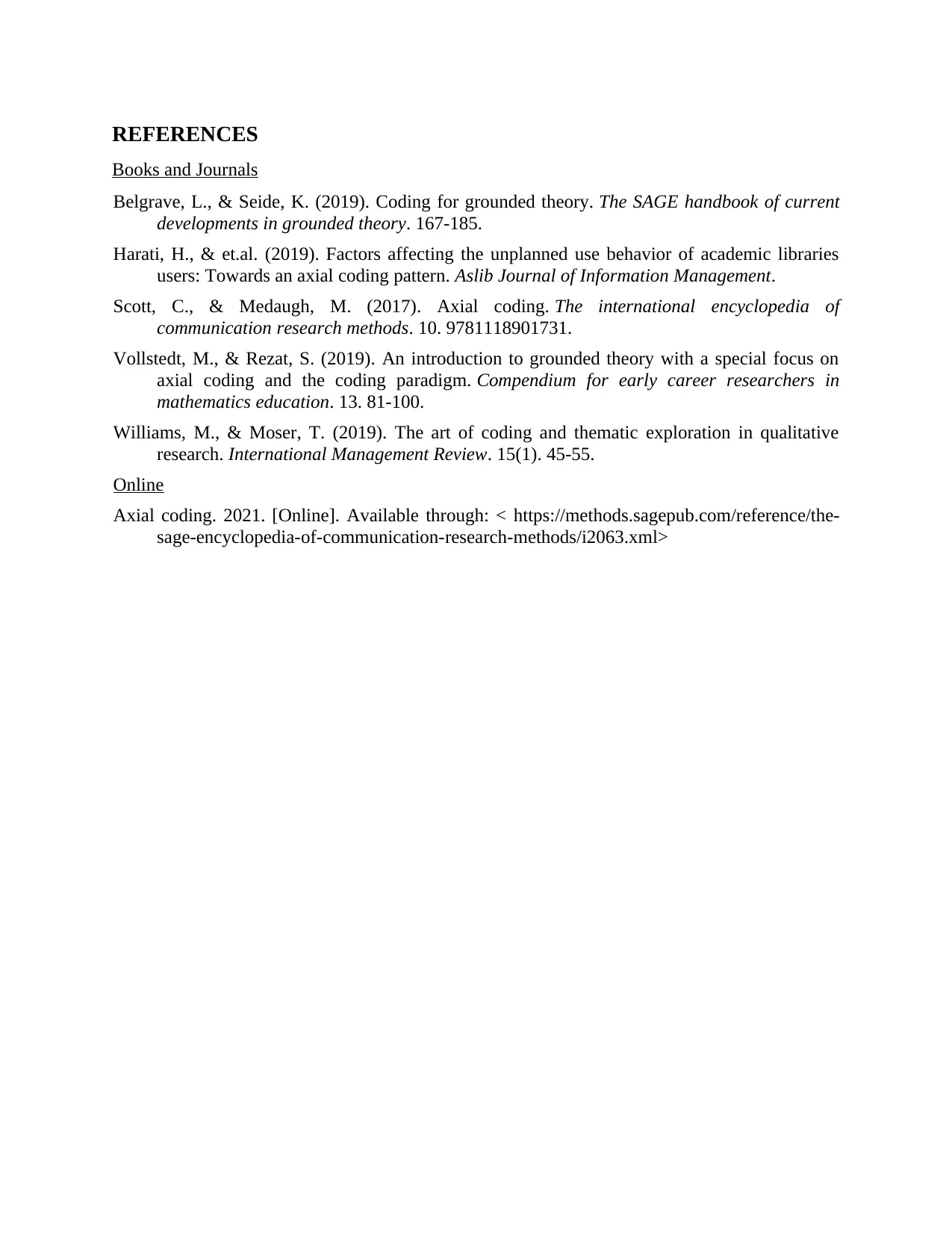
REFERENCES
Books and Journals
Belgrave, L., & Seide, K. (2019). Coding for grounded theory. The SAGE handbook of current
developments in grounded theory. 167-185.
Harati, H., & et.al. (2019). Factors affecting the unplanned use behavior of academic libraries
users: Towards an axial coding pattern. Aslib Journal of Information Management.
Scott, C., & Medaugh, M. (2017). Axial coding. The international encyclopedia of
communication research methods. 10. 9781118901731.
Vollstedt, M., & Rezat, S. (2019). An introduction to grounded theory with a special focus on
axial coding and the coding paradigm. Compendium for early career researchers in
mathematics education. 13. 81-100.
Williams, M., & Moser, T. (2019). The art of coding and thematic exploration in qualitative
research. International Management Review. 15(1). 45-55.
Online
Axial coding. 2021. [Online]. Available through: < https://methods.sagepub.com/reference/the-
sage-encyclopedia-of-communication-research-methods/i2063.xml>
Books and Journals
Belgrave, L., & Seide, K. (2019). Coding for grounded theory. The SAGE handbook of current
developments in grounded theory. 167-185.
Harati, H., & et.al. (2019). Factors affecting the unplanned use behavior of academic libraries
users: Towards an axial coding pattern. Aslib Journal of Information Management.
Scott, C., & Medaugh, M. (2017). Axial coding. The international encyclopedia of
communication research methods. 10. 9781118901731.
Vollstedt, M., & Rezat, S. (2019). An introduction to grounded theory with a special focus on
axial coding and the coding paradigm. Compendium for early career researchers in
mathematics education. 13. 81-100.
Williams, M., & Moser, T. (2019). The art of coding and thematic exploration in qualitative
research. International Management Review. 15(1). 45-55.
Online
Axial coding. 2021. [Online]. Available through: < https://methods.sagepub.com/reference/the-
sage-encyclopedia-of-communication-research-methods/i2063.xml>
⊘ This is a preview!⊘
Do you want full access?
Subscribe today to unlock all pages.

Trusted by 1+ million students worldwide
1 out of 9
Related Documents
Your All-in-One AI-Powered Toolkit for Academic Success.
+13062052269
info@desklib.com
Available 24*7 on WhatsApp / Email
![[object Object]](/_next/static/media/star-bottom.7253800d.svg)
Unlock your academic potential
Copyright © 2020–2025 A2Z Services. All Rights Reserved. Developed and managed by ZUCOL.





